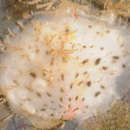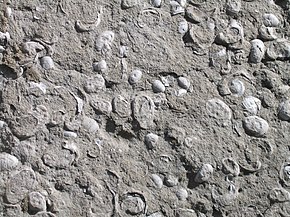en
names in breadcrumbs



The Gryphaeidae, common name the foam oysters or honeycomb oysters, are a family of marine bivalve mollusks. This family of bivalves is very well represented in the fossil record, however the number of living species is very few.
All species have shells cemented to a substrate. Shells are considered brittle, inequivalve, with the left, lower (cemented) valve convex and the right (upper, non-cemented) valve flat or slightly concave.[2]
Genera and species within this family are divided into three subfamilies, Exogyrinae, Gryphaeinae and Pycnodonteinae. Both Exogyrinae and Gryphaeinae are completely extinct. Only two genera Hyotissa and Neopycnodonte in the subfamily Pycnodonteinae have extant species.[3][4][5]
Genera and species within the family Gryphaeidae include: Family Gryphaeidae Vialov, 1936 (some genera also known as Devil's toenails)
 Praeexogyra hebridica from the Frome Clay (Bathonian, Middle Jurassic) of Langton Herring, Dorset, England.
Praeexogyra hebridica from the Frome Clay (Bathonian, Middle Jurassic) of Langton Herring, Dorset, England.  Liostrea strigilecula from the Carmel Formation (Middle Jurassic) of southwestern Utah.
Liostrea strigilecula from the Carmel Formation (Middle Jurassic) of southwestern Utah. The Gryphaeidae, common name the foam oysters or honeycomb oysters, are a family of marine bivalve mollusks. This family of bivalves is very well represented in the fossil record, however the number of living species is very few.
All species have shells cemented to a substrate. Shells are considered brittle, inequivalve, with the left, lower (cemented) valve convex and the right (upper, non-cemented) valve flat or slightly concave.
Les Gryphaeidae sont une famille de mollusques bivalves de l'ordre des Ostreida, vivantes ou fossiles.

Les Gryphaeidae, très abondantes dans certains dépôts du Lias, caractérisent le « Calcaire à gryphées », une roche lumachellique très utilisée dans certaines régions pour la construction et les dallages.
La famille des Gryphaeidae a été décrite pour le géologue ukrainien Oleg Stepanovich Vyalov (23 janvier 1904 - 1er juin 1988) en 1936. Elle comporte de très nombreux groupes fossiles parfois très abondants dans certains calcaires, mais aussi une poignée de genres actuels.
Selon World Register of Marine Species (9 janvier 2015)[2] :
Classification des taxons fossiles selon Paleobiology Database (9 janvier 2015)[3] :
Huître alvéolée (Hyotissa hyotis)
Les Gryphaeidae sont une famille de mollusques bivalves de l'ordre des Ostreida, vivantes ou fossiles.
Gryphaeidae (Anglice: foam oysters, honeycomb oysters) sunt familia marinorum molluscorum bivalvium, ad Ostreidas Pectinidasque cognata.
Genera et species intra ac familiam in tres subfamilias digeruntur: Exogyrinas, Gryphaeinas, Pycnodonteinas. Exogyrinae Gryphaeinaeque omnino sunt exstinctae, et solum tribus Pycnodonteinarum generibus sunt species exstantes: Hyotissa, Neopycnodonte, et Pycnodonte.[1]
Familia Gryphaeidae Vialov, 1936
Gryphaeidae (Anglice: foam oysters, honeycomb oysters) sunt familia marinorum molluscorum bivalvium, ad Ostreidas Pectinidasque cognata.
De Gryphaeidae is een familie van tweekleppigen uit de orde Ostreoida.
De Gryphaeidae is een familie van tweekleppigen uit de orde Ostreoida.
Gryphaeidae – rodzina małży nitkoskrzelnych z rzędu Ostreoida blisko spokrewnionych z ostrygami (Ostreidae). Muszle silnie zróżnicowane, o długości do 280 mm. Kolisty w przekroju mięsień zwieracz jest położony w pobliżu listwy zamka[2]. Rodzina obejmuje nieliczne gatunki współcześnie żyjące oraz wiele wymarłych.
Gatunki współcześnie żyjące grupowane są w rodzajach[3]:
Gryphaeidae – rodzina małży nitkoskrzelnych z rzędu Ostreoida blisko spokrewnionych z ostrygami (Ostreidae). Muszle silnie zróżnicowane, o długości do 280 mm. Kolisty w przekroju mięsień zwieracz jest położony w pobliżu listwy zamka. Rodzina obejmuje nieliczne gatunki współcześnie żyjące oraz wiele wymarłych.
Gatunki współcześnie żyjące grupowane są w rodzajach:
Empressostrea Gryphaea Hyotissa Neopycnodonte Parahyotissa Pycnodonte